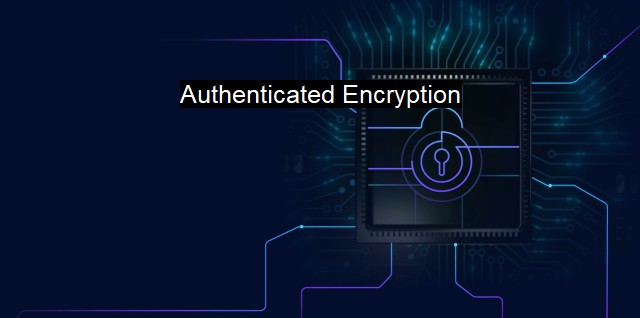What is Authenticated Encryption?
Secure Your Sensitive Information: Exploring the Role of Authenticated Encryption in Cybersecurity and Antivirus
Authenticated Encryption, often abbreviated as AE or sometimes AENC, is a term in the field of cybersecurity representing a system of encryption that simultaneously provides confidentiality, integrity, and authenticity assurances on the information. This means that AE safeguards the data from unauthorized access, ensures that it has not been tampered with and verifies that it indeed originates from a legitimate source.Confidentiality involves keeping information hidden from unauthorized or unwanted access. this typically means encrypting the data so that only someone with the correct decryption key or credentials can read it.
Integrity, in the terms of cybersecurity, refers to preserving the accuracy and completeness of data during its transmission or storage. This means that any unauthorized tampering or modification of the data can be detected and handled accordingly.
Authenticity, as the name suggests, helps confirm the legitimacy of data - indicating that the data indeed comes from the claimed source and not from an imposter. In other words, the users interacting with the data can have confidence that they are not victims of an impersonation attack such as phishing, a common cybersecurity threat.
Authenticated Encryption has both encryption and authentication steps to safeguard data. Initially, the data is encrypted using an encryption algorithm and a secret key, challenging unauthorized users to access or view the data. Subsequently, an authentication code is generated for the encrypted data. This authentication code is often referred to as a cryptographic hash or a signature, acting as a proof of integrity and authenticity. Therefore, the authenticated encryption presents an approach that tightly couples the encryption of plaintext and the authenticity of that plaintext.
That said, AE stands as an essential tool in modern cryptographic systems and is utilized thoroughly in secure communications protocols. The necessity for AE predominantly began to emerge with the realization that encryption alone, though making data unreadable, did not necessarily protect against more subtle forms of attacks that might not aim to decode the information but instead alter it in transit.
In the context of antivirus, part of the role these programs fulfill involves safeguarding data. While this can involve quarantine or deleting of malware threats, it extends to the transmission and storage of system data as cyber attackers growingly focus on data interference and theft. Thus, the importance of subscribed encryption and particularly Authenticated Encryption emerges as it aids antivirus software, ensuring that the data involved remains confidential, integral, and authentic throughout any actions performed on it.
Understandably, not all encryption algorithms are AE schemes straight away. AES (Advanced Encryption Standard) is an incredibly popular encryption algorithm but is not specifically an AE scheme. Nowadays, programmers are incorporating AE into algorithms to put out AE versions, such as AES-GCM (Galois Counter Mode) or (ChaCha20-Poly1305) which have seen wide adoption.
Given the increasing interconnectedness of computers and the Internet of Things, data integrity and security have risen to an apex of importance. Methods such as AE that help achieve the pillars of confidentiality, integrity, and authenticity in cybersecurity are vital tools to protect an organization's digital assets and to guarantee secure communication. So far, AE seems relatively successful, proving to defend against a wide plethora of well-recognized, traditional cybersecurity threats. Though the cat-and-mouse game between offender and defender in cybersecurity is seemingly perpetual, coupling encryption with authentication seems to present a sturdy defensive weapon at our current juncture.
Authenticated Encryption is a significant milestone in enhancing information security. In a world fuelled by digital data, AE indeed holds great promises and staggering potential equipping cybersecurity and antivirus programs with much-needed contexts to protect against the ever-evolving threat landscape.

Authenticated Encryption FAQs
What is authenticated encryption and how does it work in the context of cybersecurity?
Authenticated encryption is a type of encryption that not only encrypts data but also adds a message authentication code (MAC) to ensure the integrity and authenticity of the data. In the context of cybersecurity, authenticated encryption is often used to securely transmit sensitive information and protect against unauthorized access and data tampering.What are the benefits of using authenticated encryption in cybersecurity?
The benefits of using authenticated encryption in cybersecurity include increased security, data integrity, and authenticity. Authenticated encryption ensures that the data is encrypted and authenticated, making it difficult for cybercriminals to decrypt or tamper with the data. It also helps prevent attacks such as man-in-the-middle attacks and replay attacks.How does authenticated encryption differ from traditional encryption methods?
Traditional encryption methods only encrypt data but do not provide any message authentication or integrity protection. Authenticated encryption, on the other hand, combines encryption with message authentication, providing both confidentiality and integrity protection for the data being transmitted.What are some examples of authenticated encryption in cybersecurity?
Some examples of authenticated encryption commonly used in cybersecurity include AES-GCM (Advanced Encryption Standard-Galois Counter Mode), ChaCha20-Poly1305, and EAX (Encrypt-then-Authenticate-then-Encrypt). These encryption methods provide both encryption and message authentication to ensure that data is securely transmitted and protected against unauthorized access and data tampering.| | A | | | B | | | C | | | D | | | E | | | F | | | G | | | H | | | I | | | J | | | K | | | L | | | M | |
| | N | | | O | | | P | | | Q | | | R | | | S | | | T | | | U | | | V | | | W | | | X | | | Y | | | Z | |
| | 1 | | | 2 | | | 3 | | | 4 | | | 7 | | | 8 | | |||||||